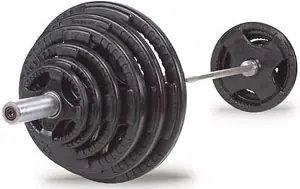Before outlining the proportion of different exercises with a barbell, it is necessary to study the positive and negative aspects of the athlete’s special physical and technical training. But how to do that?
For example, an athlete successfully copes with lifting a barbell to the chest, but he has some failures in the chest jerk. The result in the snatch is somewhat behind, but the result in the snatch with a semi-squat (130 kg) is sufficient, because it is 92.8% of the limit in the snatch (instead of 90% on average for other athletes). The lifting height of a 100% barbell in a snatch deadlift is 125 cm, which is slightly higher than the average value (121.5 cm) typical for athletes of the same height. Thus, special physical preparedness is sufficient, but there are defects in the snatch technique. The results in squats with a barbell are 255 kg (instead of 242.5 kg on average for other athletes in this weight category).
Thus, it is advisable for this athlete to increase the number of lifts in the snatch and barbell cleans. You can reduce the number of barbell cleans, squats with a barbell on the shoulders and chest, and push rows. It is also recommended to include in your training plan exercises with weights, dumbbells and other sports equipment to vary physical activity from different angles with all kinds of grips. Then the proportion of different exercises with a barbell for him may look like this:
- snatches - 23% (instead of 20% on average), while approximately 17% of lifts can be allocated to snatches (instead of 8),
- and for other jerk exercises - 6% (instead of 12);
- barbell cleans - 8% (instead of 13),
- of which approximately 3% are for classic lifts and 5% for others;
- lifts from the chest - 18% (instead of 13),
- of which 6% - for the classic push from the chest and 12% (instead of 7) - for other lifts from the chest;
- squats with a barbell on the shoulders and chest - 15% (instead of 20);
- other methods of squats - 5%;
- push rods - 5% (instead of 158 10);
- snatch rows - 8.5%;
- bench press - 7% (instead of 4.5);
- Bends with a barbell - 10.5%.
In this regime, it is very important to rely on proper sports nutrition, an excellent choice for an athlete of any level of training...
It is clear that having identified the emerging positive and negative aspects of the athlete’s special physical and technical training, and drawn up a corrective training plan, it is necessary to correct the nutrition plan. To eliminate shortcomings in a weightlifter’s performance, increase your protein intake by adding more proteins to your daily diet, as well as other sports nutrition products. Do not forget about vitamin and mineral complexes to strengthen bones and joint-ligamentous apparatus. Remember: the weakness of the entire chain is the weakness of its weakest link!
Well, in the next article of our weightlifting section we will continue to consider the positive and negative aspects of the special physical and technical training of an athlete in weightlifting. Be healthy!
Post Views: 140


